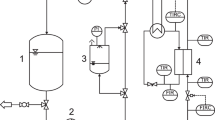Abstract
Gas and water vapour transport properties are of main concern in evaluating the suitability of a polymeric material to be used as a protective for monuments. In this work, oxygen, carbon dioxide and water vapour transport properties have been investigated for a new class of polymers, fluorinated polyurethanes, which have been recently proposed as a protective material for stone monuments. They consist of block copolymers made of hydrophilic polyurethane and hydrophobic perfluoropolyether blocks. The properties of these copolymers are expected to be strongly related to the relative amounts of these two blocks.
In this investigation, three different types of fluorinated polyurethane copolymers were considered in order to assess the effect of chemical composition and physical morphology on mass transport properties. In particular, sorption and permeation experiments were performed at 30°C to evaluate permeabilities, diffusivities and solubilities.
In fact, the analysis of the effect of chemical composition on transport properties can give useful selection criteria to tailor the material to be used as a protective.
Résumé
Il est important de connaître les propriétés de transport des gaz et de la vapeur d'eau d'un polymère lorsqu'on l'évalue en tant que matériau de protection pour les monuments. On a étudié les propriétés de transport de l'oxygène du dioxyde de carbone et de la vapeur d'eau d'une nouvelle classe de polymères, les polyuréthanes fluorés, récemment proposés pour protéger des monuments en pierre. Ce sont des copolymères en bloc, constitués de blocs de polyuréthane hydrophile et de blocs de perfluoropolyether hydrophobe. On s'attend à ce que les propriétés de ces copolymères correspondent étroitement aux quantités relatives de ces deux blocs.
Dans cette investigation, on a évalué l'effet de la composition chimique et de la morphologie physique sur des propriétés de transport en masse de trois types de copolymère polyuréthane fluoré. En particulier, des essais de sorption et de pénétration ont été effectués à 30°C pour évaluer leurs perméabilités, leurs diffusivités et leurs solubilités.
En effet, l'analyse de l'effet de la composition chimique sur les propriétés de transfert peut fournir des critères de sélection utiles pour la choix de matériaux de protection.
Similar content being viewed by others
References
Borselli, G., Camaiti, M., Pasetti, A., Maravelaki, P., and Matteoli, U., ‘La conservazione del patrimonio monumentale, Protettivi impiegati nella conservazione dei materiali lapidei: storia, impieghi e sviluppi’,L'edilizia 1 (1990) 67–78.
Moggi, G., ‘Advances in fluoropolymer protection of natural stones and related synthetic materials’, Proceedings of the XVth International Conference on Organic Coatings Science and Technology, Athens, July 1989, 283–298.
Frediani, P., Manganelli Del Fa, C., Matteoli, U. and Tiano, P., ‘Use of perfluoropolyethers as water repellents: Study of their behaviour on Pietra Serena, a Florentine building stone’,Studies in Conservation 27 (1982) 31–37.
Mensitieri, G., Del Nobile, M. A., Bellucci, F., and Nicodemo, L., ‘The effect of film thickness on oxygen sorption and transport in dry and water-saturated Kapton polymide’,J. Membr. Sci. 89 (1994) 131–141.
Stern, S. A. and Trohalaki, S., ‘Foundamentals of gas diffusion in rubbery and glassy polymers’, in ‘Barrier Polymers and Structures’, Koros, W. J. Ed., ACS Symp. Series 423 (Washington D.C., 1990) Chap. 2, 22–59.
Flory, P.J., ‘Principles of Polymer Chemistry’, (Cornell University Press, Ithaca and London, 1953).
Barrer, R.M., Barrie, J.A. and Slater, J., ‘Sorption and diffusion of ethyl cellulose. Part III. Comparison between ethyl cellulose and rubber’,J. Polym. Sci. 27 (1958) 177–197.
Koros, W.J. and Paul, D.R., ‘CO2 sorption in poly(ethylene terephthalate) above and below the glass transition’,J. Polym. Sci., Polym. Phys. Ed. 16 (1978) 1947–1963.
Paul, D.R., ‘Gas soprtion and transport in glassy polymers’,Ber. Bunsenges. Phys. Chem. 83 (1979) 294–302.
Barrer R.M., ‘Some properties of diffusion coefficients in polymers’,J. Phys. Chem., Wash. 61 (1957) 178–188.
Koros, W.J. and Paul, D.R., ‘Design considerations for measurements of gas sorption in polymers by pressure decay’,J. Polym. Sci., Polym. Phys. Ed. 14 (1976) 1903–1904.
Mensitieri, G., Del Nobile M.A., Sommazzi, A., Nicolais, L., ‘Water transport in a polyketone terpolymer’,J. Polym. Sci. Phys. Ed. 33 (1995) 1365–1370.
Crank, J., ‘The Mathematics of Diffusion’, 2nd Edn. (Clarendon Press, Oxford, 1975).
Koros, W.J. and Paul, D.R., ‘CO2 sorption in poly(ethylene terephthalate) above and below the glas transition’,op. cit. [8].
Koros, W.J. and Hellums, M.W., ‘Encyclopedia of Polymer Science and Engineering’, Supplement volume (John Wiley and Sons Publ., New York, 1990) 724–802.
Michaels, A.S., and Parker Jr, R.B., ‘Sorption and flow of gases in polyethylene’,J. Polym. Sci. 41 (1959) 53–71.
Michaels, A.S. and Bixler, H.J., ‘Solubility of gases in polyethylene’,J. Polym. Sci. 50 (1961) 393–412.
Michaels, A.S. and Bixler, H.J., ‘Flow of gases through polyethylene’,J. Polym. Sci. 50 (1961) 413–439.
Author information
Authors and Affiliations
Rights and permissions
About this article
Cite this article
Antonucci, V., Mastrangeli, C., Mensitieri, G. et al. Gas and water vapour transport through polymer based protective materials for stone monuments: Fluorinated polyurethanes. Mat. Struct. 31, 104–110 (1998). https://doi.org/10.1007/BF02486472
Received:
Accepted:
Issue Date:
DOI: https://doi.org/10.1007/BF02486472




